Citroen C4 AIRCROSS RHD 2014.5 1.G Owner's Manual
Manufacturer: CITROEN, Model Year: 2014.5, Model line: C4 AIRCROSS RHD, Model: Citroen C4 AIRCROSS RHD 2014.5 1.GPages: 389, PDF Size: 15.51 MB
Page 191 of 389
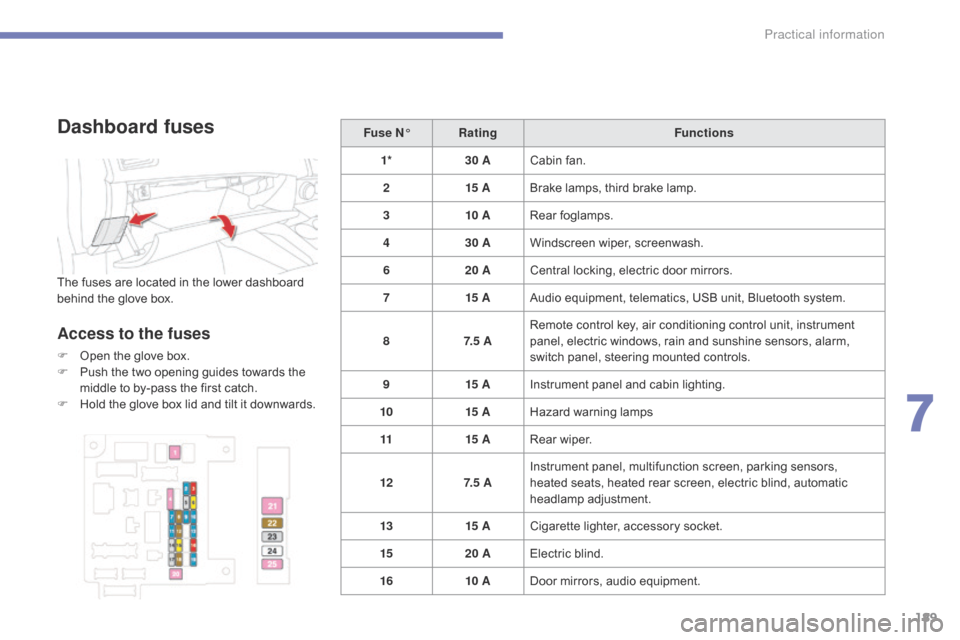
189
Dashboard fuses
The fuses are located in the lower dashboard
behind the glove box.
Access to the fuses
F Open the glove box.
F P ush the two opening guides towards the
middle to by-pass the first catch.
F
H
old the glove box lid and tilt it downwards. Fuse N°
Rating Functions
1* 30 ACabin fan.
2 15 ABrake lamps, third brake lamp.
3 10 ARear foglamps.
4 30 AWindscreen wiper, screenwash.
6 20 ACentral locking, electric door mirrors.
7 15 AAudio equipment, telematics, USB unit, Bluetooth system.
8 7. 5 ARemote control key, air conditioning control unit, instrument
panel, electric windows, rain and sunshine sensors, alarm,
switch panel, steering mounted controls.
9 15 AInstrument panel and cabin lighting.
10 15 AHazard warning lamps
11 15 ARear wiper.
12 7. 5 AInstrument panel, multifunction screen, parking sensors,
heated seats, heated rear screen, electric blind, automatic
headlamp adjustment.
13 15 ACigarette lighter, accessory socket.
15 20 AElectric blind.
16 10 ADoor mirrors, audio equipment.
7
Practical information
Page 192 of 389
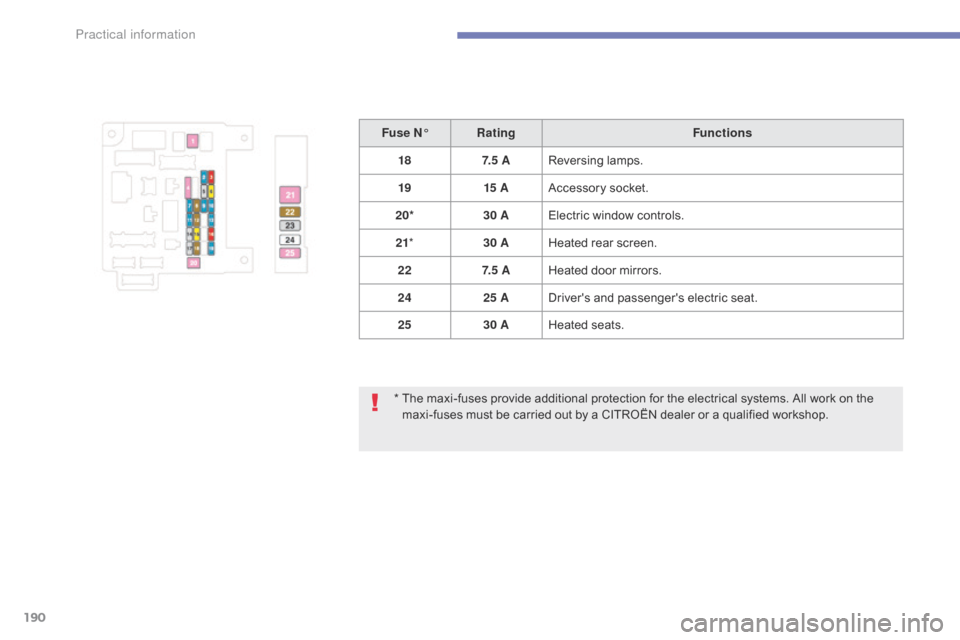
190
* The maxi-fuses provide additional protection for the electrical systems. All work on the maxi-fuses must be carried out by a CITROËN dealer or a qualified workshop.
Fuse N°
Rating Functions
18 7. 5 AReversing lamps.
19 15 AAccessory socket.
20* 30 AElectric window controls.
21 * 30 AHeated rear screen.
22 7. 5 AHeated door mirrors.
24 25 ADriver's and passenger's electric seat.
25 30 AHeated seats.
Practical information
Page 193 of 389
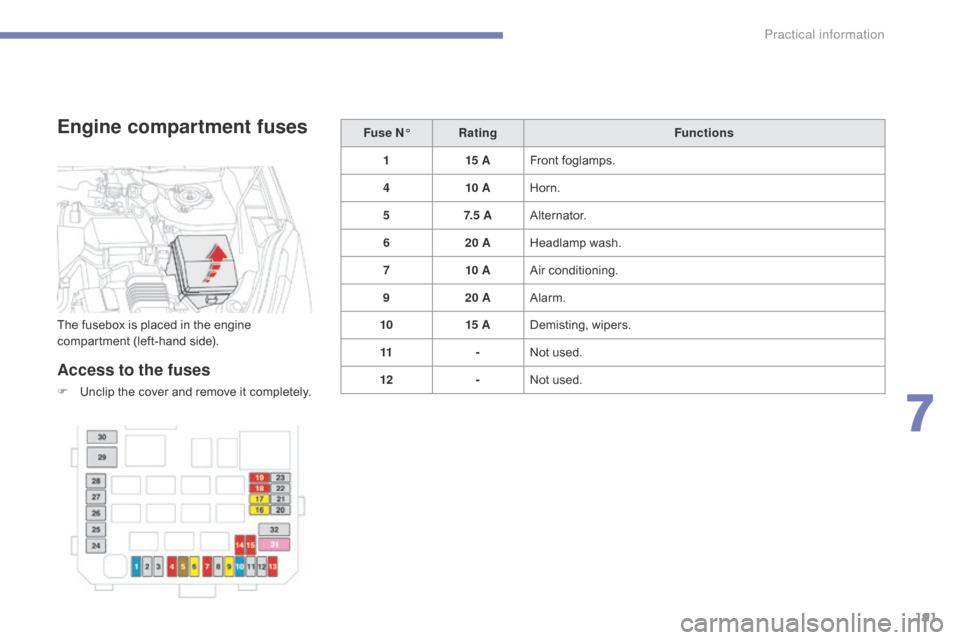
191
Engine compartment fuses
Access to the fuses
F Unclip the cover and remove it completely.Fuse N°
Rating Functions
1 15 AFront foglamps.
4 10 AHorn.
5 7. 5 AAlternator.
6 20 AHeadlamp wash.
7 10 AAir conditioning.
9 20 AAlarm.
10 15 ADemisting, wipers.
11 -Not used.
12 -Not used.
The fusebox is placed in the engine
compartment (left-hand side).
7
Practical information
Page 194 of 389
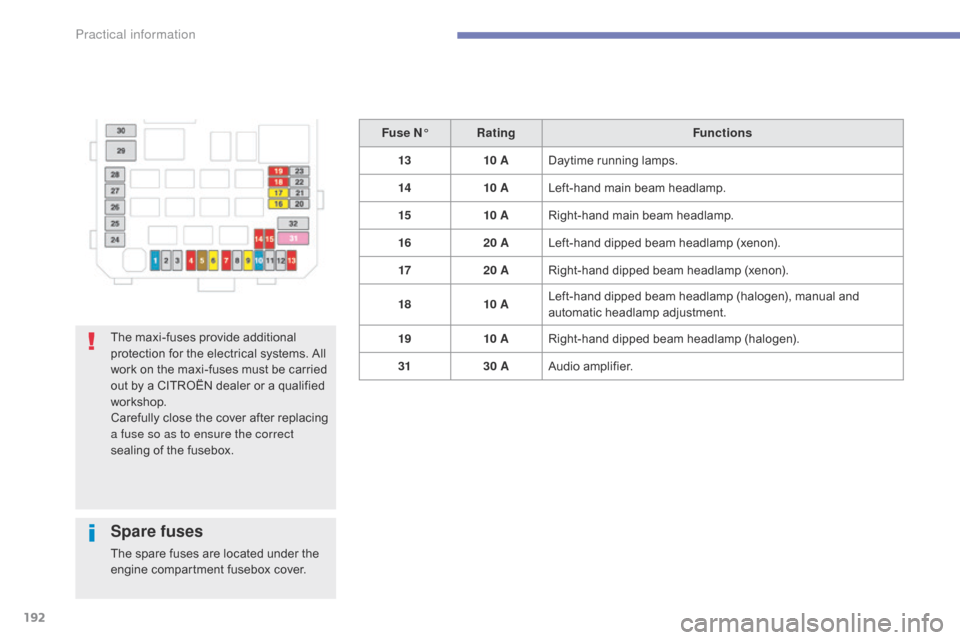
192
Fuse N°Rating Functions
13 10 ADaytime running lamps.
14 10 ALeft-hand main beam headlamp.
15 10 ARight-hand main beam headlamp.
16 20 ALeft-hand dipped beam headlamp (xenon).
17 20 ARight-hand dipped beam headlamp (xenon).
18 10 ALeft-hand dipped beam headlamp (halogen), manual and
automatic headlamp adjustment.
19 10 ARight-hand dipped beam headlamp (halogen).
31 30 AAudio amplifier.
The maxi-fuses provide additional
protection for the electrical systems. All
work on the maxi-fuses must be carried
out by a CITROËN dealer or a qualified
workshop.
Carefully close the cover after replacing
a fuse so as to ensure the correct
sealing of the fusebox.
Spare fuses
The spare fuses are located under the
engine compartment fusebox cover.
Practical information
Page 195 of 389
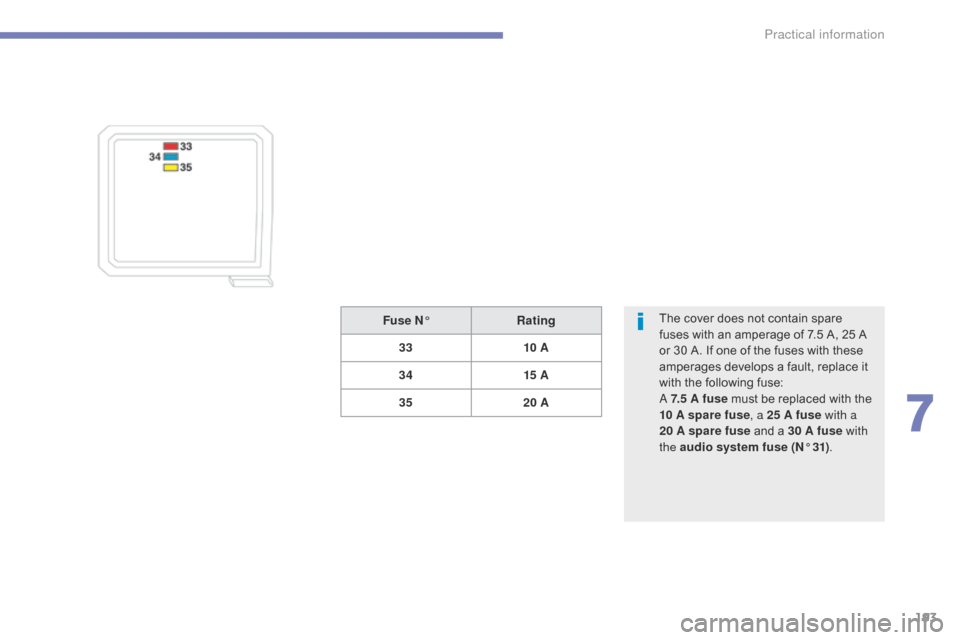
193
The cover does not contain spare
fuses with an amperage of 7.5 A, 25 A
or 30 A. If one of the fuses with these
amperages develops a fault, replace it
with the following fuse:
a
7.5 A fuse must be replaced with the
10 A spare fuse , a 25 A fuse with a
20
A spare fuse and a 30 A fuse with
the audio system fuse (N° 31) .
Fuse N°
Rating
33 10 A
34 15 A
35 20 A
7
Practical information
Page 196 of 389
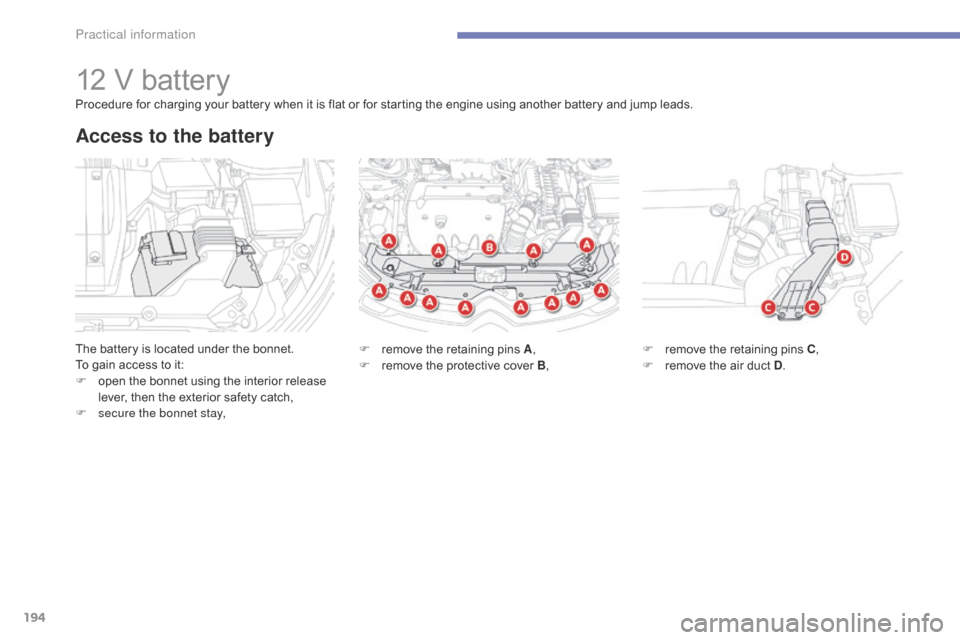
194
12 V battery
The battery is located under the bonnet.
To gain access to it:
F
o
pen the bonnet using the interior release
lever, then the exterior safety catch,
F
s
ecure the bonnet stay,
Access to the battery
Procedure for charging your battery when it is flat or for starting the engine using another battery and jump leads.
F
r
emove the retaining pins A,
F
r
emove the protective cover B,F
r
emove the retaining pins C,
F
r
emove the air duct D.
Practical information
Page 197 of 389
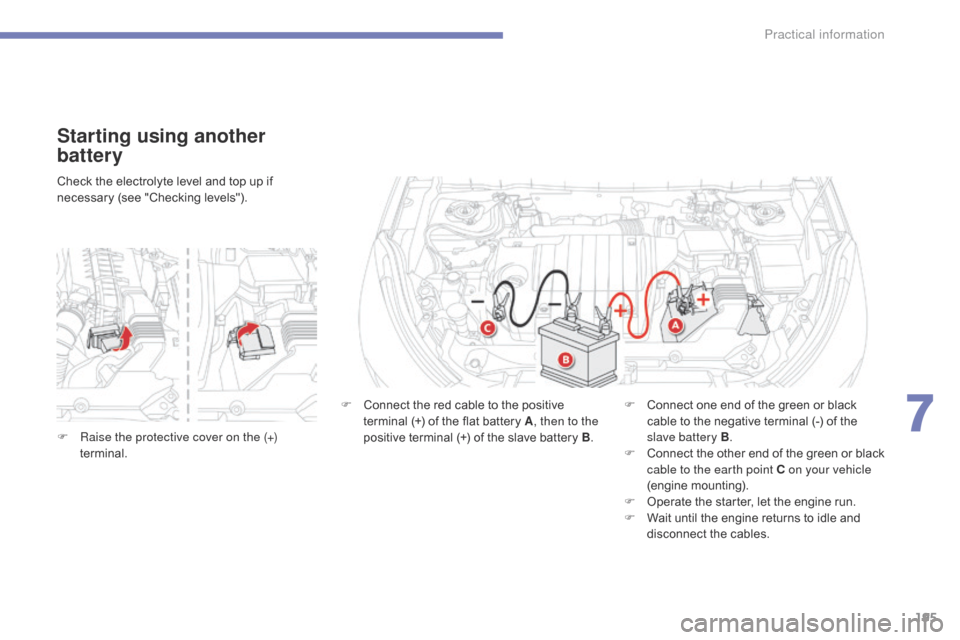
195
Check the electrolyte level and top up if
necessary (see "Checking levels").
Starting using another
battery
F Connect the red cable to the positive terminal (+) of the flat battery A , then to the
positive terminal (+) of the slave battery B. F
C onnect one end of the green or black
cable to the negative terminal (-) of the
slave battery B .
F
C
onnect the other end of the green or black
cable to the earth point C on your vehicle
(engine mounting).
F
O
perate the starter, let the engine run.
F
W
ait until the engine returns to idle and
disconnect the cables.
F
R
aise the protective cover on the (+)
terminal.
7
Practical information
Page 198 of 389
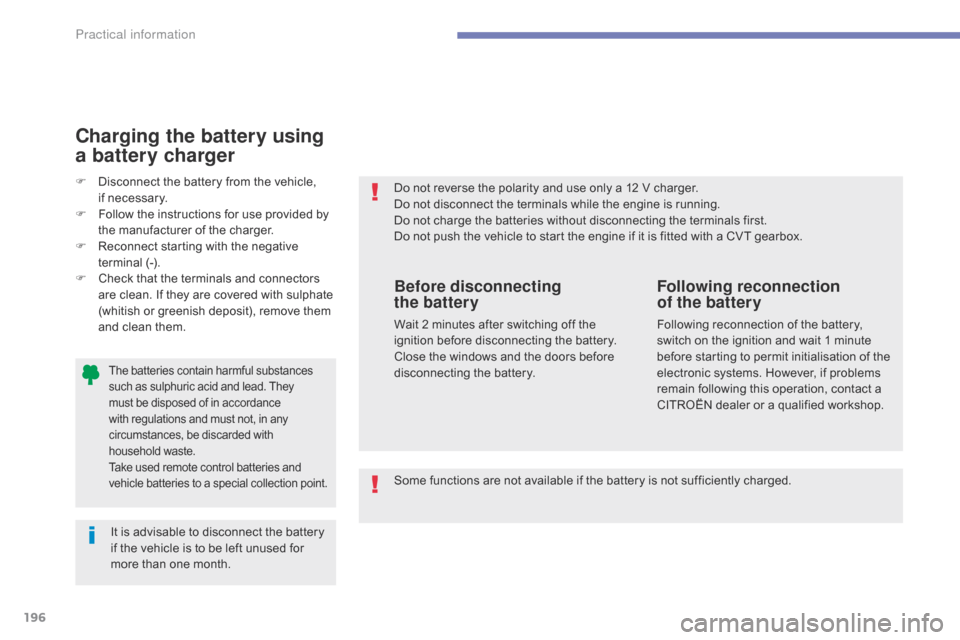
196
The batteries contain harmful substances
such as sulphuric acid and lead. They
must be disposed of in accordance
with regulations and must not, in any
circumstances, be discarded with
household
w
aste.
Take used remote control batteries and
vehicle batteries to a special collection point.
Do not reverse the polarity and use only a 12 V charger.
D o not disconnect the terminals while the engine is running.
Do not charge the batteries without disconnecting the terminals first.
Do not push the vehicle to start the engine if it is fitted with a CVT gearbox.
It is advisable to disconnect the battery
if the vehicle is to be left unused for
more than one month.
Before disconnecting
the battery
Wait 2 minutes after switching off the
ignition before disconnecting the battery.
Close the windows and the doors before
disconnecting the battery.
Following reconnection
of the battery
Following reconnection of the battery,
switch on the ignition and wait 1 minute
before starting to permit initialisation of the
electronic systems. However, if problems
remain following this operation, contact a
CITROËN dealer or a qualified workshop.
F
D
isconnect the battery from the vehicle,
if
necessary.
F
F
ollow the instructions for use provided by
the manufacturer of the charger.
F
R
econnect starting with the negative
terminal (-).
F
C
heck that the terminals and connectors
are clean. If they are covered with sulphate
(whitish or greenish deposit), remove them
and clean them.
Charging the battery using
a battery charger
Some functions are not available if the battery is not sufficiently charged.
Practical information
Page 199 of 389
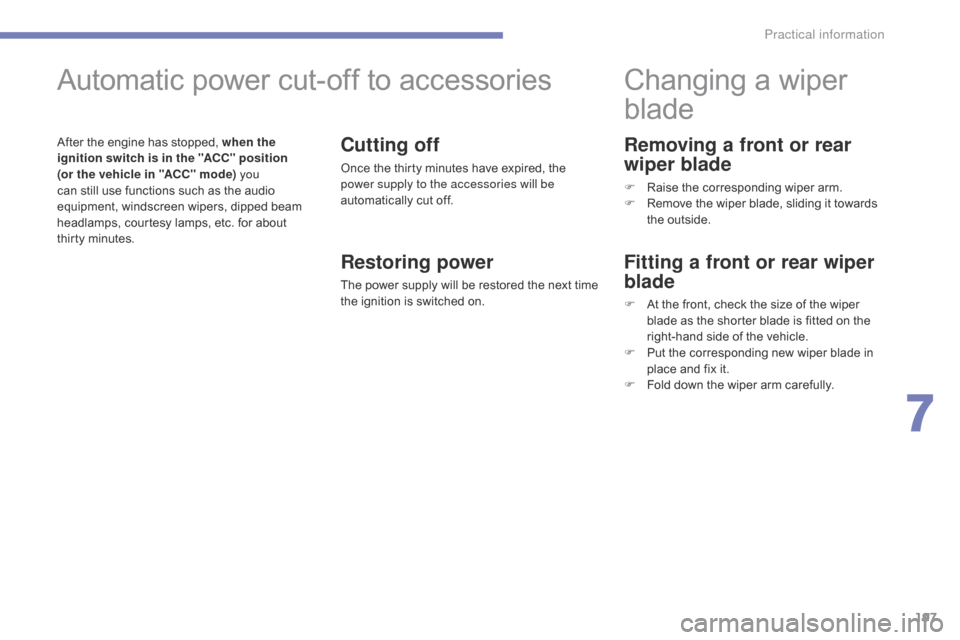
197
Removing a front or rear
wiper blade
F Raise the corresponding wiper arm.
F R emove the wiper blade, sliding it towards
the outside.
Changing a wiper
blade
Fitting a front or rear wiper
blade
F At the front, check the size of the wiper blade as the shorter blade is fitted on the
right-hand side of the vehicle.
F
P
ut the corresponding new wiper blade in
place and fix it.
F
F
old down the wiper arm carefully.
Automatic power cut-off to accessories
After the engine has stopped, when the
ignition switch is in the "ACC" position
(or the vehicle in "ACC" mode) you
can still use functions such as the audio
equipment, windscreen wipers, dipped beam
headlamps,
courtesy lamps, etc. for about
thirty
m
inutes.Cutting off
Once the thirty minutes have expired, the
power supply to the accessories will be
automatically cut off.
Restoring power
The power supply will be restored the next time
the ignition is switched on.
7
Practical information
Page 200 of 389
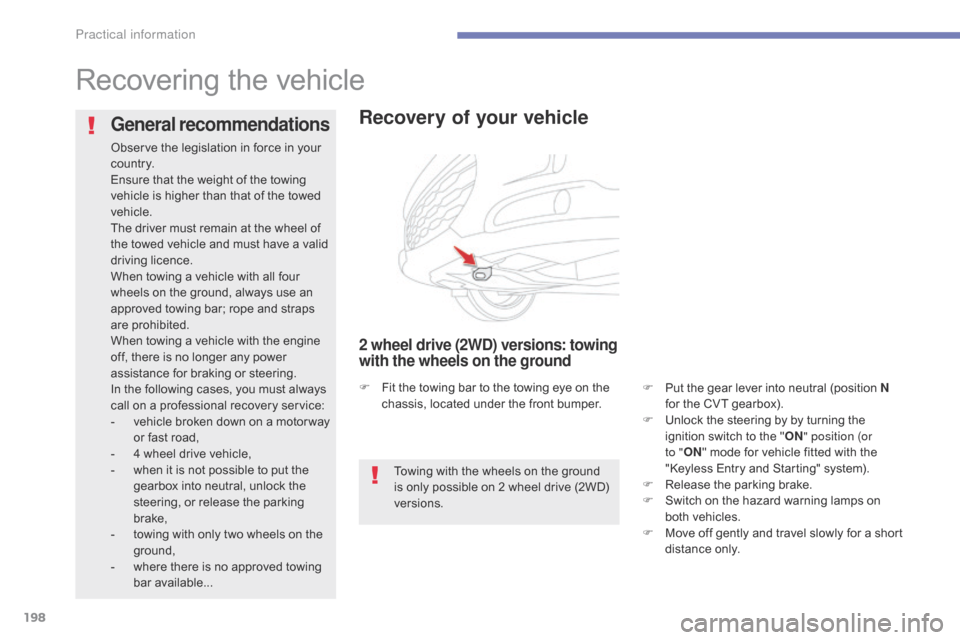
198
Recovering the vehicle
Recovery of your vehicle
2 wheel drive (2WD) versions: towing
with the wheels on the ground
F Put the gear lever into neutral (position N
for the CVT gearbox).
F
U
nlock the steering by by turning the
ignition switch to the " ON" position (or
to " ON " mode for vehicle fitted with the
"Keyless Entry and Starting" system).
F
R
elease the parking brake.
F
S
witch on the hazard warning lamps on
both vehicles.
F
M
ove off gently and travel slowly for a short
distance only.
General recommendations
Observe the legislation in force in your
c o unt r y.
Ensure that the weight of the towing
vehicle is higher than that of the towed
vehicle.
The driver must remain at the wheel of
the towed vehicle and must have a valid
driving licence.
When towing a vehicle with all four
wheels on the ground, always use an
approved towing bar; rope and straps
are prohibited.
When towing a vehicle with the engine
off, there is no longer any power
assistance for braking or steering.
In the following cases, you must always
call on a professional recovery service:
-
v
ehicle broken down on a motor way
or fast road,
-
4 w
heel drive vehicle,
-
w
hen it is not possible to put the
gearbox into neutral, unlock the
steering, or release the parking
brake,
-
t
owing with only two wheels on the
ground,
-
w
here there is no approved towing
bar available... Towing with the wheels on the ground
is only possible on 2 wheel drive (2WD)
versions.
F
F
it the towing bar to the towing eye on the
chassis, located under the front bumper.
Practical information